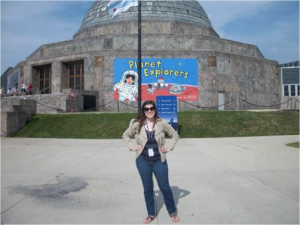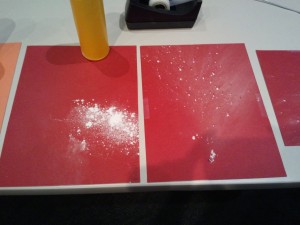Today we have a blog post comes from our awesome summer intern, Julie A. Feldt, who is finishing up a graduate certificate in museum studies at the University of Michigan. Julie has a background in astronomy and space physics research with experience in education and public outreach. She is looking into a career as an informal science educator, and after this summer she will continue to volunteer with us on the project she has written about.
To finish up my Museum Studies Certificate from the University of Michigan, I have been interning with the Zooniverse Educators by working on developing their Skype in the Classroom program. Skype in the Classroom is an extension to Skype that allows teachers to network with other teachers and professionals of various fields to create unique experiences for their students. In addition to working on my main project, I have enjoyed participating in school visits around Chicago, assisting in organizing the Zooniverse Teacher Ambassador workshop, and in a workshop on developing ZooTools tutorials.

To develop this program for Zooniverse Education I researched Skype in the Classroom and Google+ to understand:
-
How do other Museums use Skype in the Classroom or Google+ to provide lessons?
-
What is the best way to connect with Teachers?
-
What kind of experience are Teachers looking for?
Other museums typically provide lessons that are formatted to start with a brief lecture on background with activities to teach the main lesson. The end of the lesson is followed up with a question and answer session between the students and museum educator or professional. There seems to be many more museums using Google+, but their audience for activities using Google Hangouts is open to more than just teachers and their classrooms. Skype in the Classroom offers the choice of selecting teachers based on the age groups they teach, subjects they cover, and that speak a common language. Teachers have advertised on Skype in the Classroom with interest in meeting a classroom from another area of the world, a professional from the field they teach in, and to network with other teachers on strategies for teaching certain concepts.
After talking over ideas with the Zooniverse Educators, we came up with a “Meet the Scientist” series and virtual Zooniverse school visits. The “Meet the Scientist” Series is starting off with Dr. Karen Masters from the Galaxy Zoo project. The lesson focuses on giving kids a deeper understanding of classification which then leads to classifying galaxies on Galaxy Zoo using a Navigator group. This lesson is followed up with a question and answer session between the scientist and students. The school visit lesson has been done around the Chicago area, but since Zooniverse is a multi-institutional organization that spans different countries there should be the option to talk with classrooms anywhere that are interested in Zooniverse projects. For this first test I chose to develop an activity for the Planet Four project. There has been a lot of attention on Mars in the news and with the recent deployment of Curiosity. This activity helps demonstrate the patterns that Planet Four project scientists are looking for on the Martian surface, by replicating the gas geysers. Students can test out the different situations that cause either blotches or fans to occur, as well as talk through how unique patterns may form. When the main activity of this lesson was tested on the museum floor during the 1 year anniversary of Curiosity on Mars, visitors enjoyed the experience and felt motivated to use the Planet Four project.

The first test of “Meet the Scientist” was conducted at our Zooniverse Teacher Ambassadors workshop where the teachers were our middle school class for Karen and I to present to. They provided us with some very helpful feedback to improve our lesson and presentation. Now we are preparing to work with a classroom. Testing has helped identify possible issues; such as ability to screen share, teachers possibly not able to get all the materials together, and other technical problems with connection. As technology advances some of these issues will get better and lessons can always be slightly altered to accommodate the individual teacher’s situation.
Overall, this seems like it will be a great way to reach more schools around the world with the educational opportunities Zooniverse has to offer. Also, with the idea of these two types of lessons being series, Zooniverse educators are open to develop lessons for other Zooniverse projects to bring different types of experiences to the classroom. There will still need to be more testing to smooth out the lesson plans. I will continue to work on this project as a volunteer during the testing phase. Soon, I will post these two lessons on Zooniverse’s partner page on Skype in the Classroom. There will be advertisements about it on here and the Skype in the Classroom Twitter account. If you are interested in providing this experience for your students, it is easy to sign up on Skype in the Classroom (https://education.skype.com/), especially if you already have a Skype account, and you will be able to find this and many other types of opportunities for your class or to share with your fellow teachers!



One thought on “Interning with Zooniverse Education”